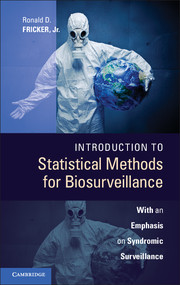Book contents
- Frontmatter
- Content
- Preface
- Acknowledgments
- Part I Introduction to Biosurveillance
- Part II Situational Awareness
- Part III Early Event Detection
- Part IV Putting It All Together
- 9 Applying the Temporal Methods to Real Data
- 10 Comparing Methods to Better Understand and Improve Biosurveillance Performance
- Part V Appendices
9 - Applying the Temporal Methods to Real Data
from Part IV - Putting It All Together
Published online by Cambridge University Press: 05 March 2013
- Frontmatter
- Content
- Preface
- Acknowledgments
- Part I Introduction to Biosurveillance
- Part II Situational Awareness
- Part III Early Event Detection
- Part IV Putting It All Together
- 9 Applying the Temporal Methods to Real Data
- 10 Comparing Methods to Better Understand and Improve Biosurveillance Performance
- Part V Appendices
Summary
…the fact that the criterion we happen to use has a fine ancestry of highbrow statistical theorems does not justify its use. Such justification must come from empirical evidence that it works.
Walter A. Shewhart (1891–1967)This chapter brings together everything from the past eight chapters, demonstrating the application of early event detection (EED) methods for both natural disease detection and bioterrorism detection. In so doing, it highlights that effective detection depends on specifically defining the surveillance purpose. Current biosurveillance system design and practice typically do not do so. However, it does not follow that a system operated for detecting natural diseases will be most effective at detecting bioterrorism and vice versa.
In particular, determining whether an abnormality is present requires defining the normal background disease incidence. For seasonal outbreak detection, normal disease incidence should be characterized using historical data from periods without seasonal outbreaks. In contrast, for short-term outbreaks such as bioterrorism, seasonal outbreaks are part of the normal disease incidence and thus must be incorporated into the background disease incidence. For example, during flu season, EED methods looking for bioterrorism must account for the elevated flu incidence before assessing whether a bioterrorism attack may or may not have occurred.
- Type
- Chapter
- Information
- Introduction to Statistical Methods for BiosurveillanceWith an Emphasis on Syndromic Surveillance, pp. 253 - 280Publisher: Cambridge University PressPrint publication year: 2013



